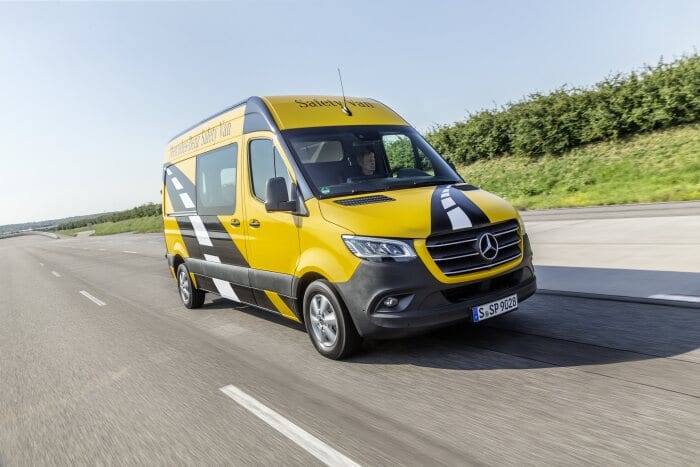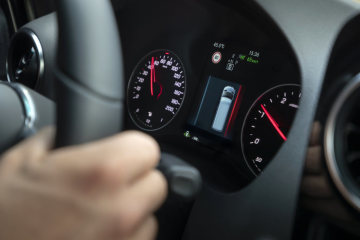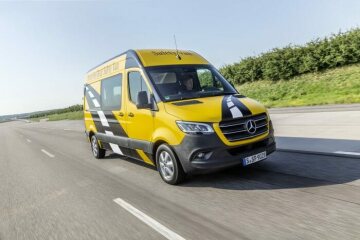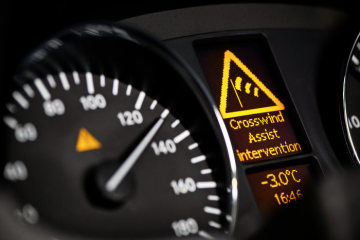
09.
October 2020
Stuttgart
- A 25-year success story: the Mercedes-Benz Sprinter van has been the epitome of safety from the very start
- Disk brakes all-around, anti-lock braking system and driver airbag define safety in the van segment for vehicles with a gross vehicle mass of between 2.8 and 4.6 tonnes.
- With every facelift and new generation, the Sprinter has further improved its position with regard to active and passive safety.
- ADAPTIVE ESP®, Crosswind Assist and numerous other driver assistance systems right through to Active Distance Assist Distronic assist the driver and protect all road users.
Stuttgart. In 1995 Mercedes-Benz presented a newly developed van that quickly advanced to become the reference model, characterising an entire vehicle category. From the start of its development it was clear that both active and passive safety would be central components of the vehicle concept. Since then the Sprinter has maintained its pioneer role in this discipline without interruption. This starts with its handling which is very similar to that of a passenger car and through to its "hard" technology such as ABS and airbags as well as the latest generation of driving assistance systems. Thus, now in its third generation, the Mercedes-Benz Sprinter continues to consistently raise the bar for other vans.
1995: even the very first Sprinter has extensive safety technology
In 1995 no other van offers more safety features. The package includes disk brakes all-around, an ABS anti-lock braking system as standard, automatic brake differential, a driver airbag on request, three-point seat belts adjustable in height and seat belt buckles attached to the seat. The comfortable suspension and passenger-car-like handling are also features that must not be underestimated. That's because: drivers who are more relaxed, remain alert for longer and thus drive more safely. This is the basis for the Sprinter's reputation as an epitome of safety.
And development doesn't stop there: in 2000 the Sprinter is given more powerful headlamps as part of an extensive facelift. In addition to active safety, Mercedes-Benz continues to advance passive safety too. The driver airbag is now included in the standard equipment while a co-driver airbag is optionally available. The double airbag is particularly large and also protects the passenger occupying the inner seat of a co-driver bench seat. The driver cockpit is also redesigned to maintain the driver's level of fitness: the cockpit now has the appearance of a passenger car. The gear stick is redesigned as a control lever and relocated to an easy-to-reach height; this further improves ergonomics – and in turn safety. The next safety feature is introduced in 2001: windowbags are now also available.
In 2002 the Sprinter sets the benchmark yet again with ESP® installed as standard
In 2002 the Sprinter is further refined. New features include a more powerful brake booster and the Electronic Stability Program ESP®, installed as standard initially in the closed variant of the Sprinter up to a gross vehicle mass of 3.5 t. ESP® is a revolution in the safety technology of vans because it can actively assist the driver in critical driving situations. Two years later ESP® is included in the standard equipment of all Sprinter chassis up to a gross vehicle mass of 3.5 t. A measure with results: in the following years the statistics show accidents caused by the vehicle "leaving the roadway" to be drastically reduced. Just one year later, the "Van Training on Tour" complements technical aspects with driver instruction.
The second generation Sprinter from 2006: safer than ever with ADAPTIVE ESP®
Consistent introduction of innovations continues; this is emphasised by the completely new second-generation Mercedes-Benz Sprinter in 2006. This new generation does not only boast a significantly increased cargo capacity – a GFRP transverse leaf spring at the front axle and new parabolic springs at the rear axle, soon complemented by an optional air suspension, improve both comfort and safety. The Sprinter is now even more comfortable which is particularly apparent in the driver's level of fitness on long-distance journeys.
As ADAPTIVE ESP® the system now adapts to various loading conditions thanks to mass and centre of gravity detection and thus control is more precise and specific in critical driving situations. The same applies to adapting to different bodies. ESP® is optionally enhanced with start-off assist: it prevents the vehicle inadvertently rolling backwards as it pulls away on an incline.
Additional adjustable wide-angle mirror glass in the new outside mirrors provides the best possible view to the rear and static curve lights are also available on request. A rain and light sensor takes care of switching the windscreen wipers and driving lights on and off. All Sprinter vans have 16-inch wheels, the pre-requirement for brake disks with a large diameter and the corresponding performance. As a preventive measure the Sprinter is also available with thoraxbags in addition to the front airbags.
In 2009 ESP® receives another function; trailer stabilisation. Furthermore, Mercedes-Benz introduces adaptive brake lights. Thanks to heated outside mirrors the wide-angle mirror glass is now demisted and the front fog lamps are relocated to a lower position to better illuminate the road. The optional automatic transmission now includes start-off assist.
2013: new Sprinter with revolutionary driver assistance systems
In the summer of 2013 the new Sprinter also brings new driver assistance systems – some of them world premieres for vans. Crosswind Assist celebrates its debut for example. It almost completely compensates the effects of gusts of wind on the vehicle as far as physically possible. Standard equipment on all closed variants, it is soon available for Sprinters with separate bodies such as box bodies or camper vans.
COLLISION PREVENTION ASSIST comprises the functions distance warning, adaptive braking assistance system Brake Assist Pro and a further warning stage in the event of an acute risk of collision. Blind Spot Assist warns drivers of vehicles in the neighbouring lane or in the so-called blind spot when changing lanes. Lane Keeping Assist warns the driver about leaving the lane inadvertently by monitoring the roadway ahead and its markings. High Beam Assist ensures that the lane is optimally illuminated with situative activation and deactivation of the main beam headlamps. As a result, dazzling approaching vehicles or those driving ahead is almost impossible.
With these driver assistance systems Mercedes-Benz underscores its pioneering role in safety technology for vans. A decisive advantage of the new driver assistance systems: they help to avoid accidents. This also applies to measures involving the suspension: lowering the suspension by 30 mm increases vehicle dynamics and steering precision perceptibly thanks to a lower centre of gravity. The safe Sprinter now drives even more safely.
2018: the third generation of the Sprinter further increases safety
Connectivity and diversity are the focus of the third generation of Sprinters. However with regard to the safety features, Mercedes-Benz Vans also raises the vehicle to a new level. Active Distance Assist DISTRONIC, for example, can relieve the driver by automatically maintaining sufficient distance to the vehicle ahead from a speed of 20 km/h. A radar sensor in the front bumper determines the data required for this. The system detects lane changes or braking manoeuvres of other road users and can react immediately – in an emergency the active distance warning assistance system can brake the Sprinter to a standstill.
Other driver assistance systems introduced to the new Sprinter include a reversing camera with an image in the inside rearview mirror and a modern parking package with 360-degree all-around visibility. A rain sensor and wipers with integrated Wet Wiper System provide for optimum visibility even when the windscreen is being cleaned.
Prevention is better than cure
Since 1995 the following applies for the development of the Sprinter: prevention is better than cure; accident prevention is better than mitigating their consequences. The Sprinter benefits both from its passenger-car-like driving style and the development of driver assistance systems for Mercedes-Benz passenger cars. Their safety technology has also been introduced to the Sprinter – adapted to the special requirements and conditions of vans.
Press Contact
- Manager Global Product Communications Sprinter
- albrecht.eckl@daimler.com
- Tel: +49 160 8614752
- Manager Global Product Communications Mercedes-Benz Vans
- ingeborg.gaertner@daimler.com
- Tel: +49 160 8670044
Press Contact Overview
Media
Download
Filter
Show thumbnails
Show list
Slideshow
Settings
- Preview

Do you really want to delete the data record?
Please wait a moment …
Please wait a moment …
Please wait a moment …
Please wait a moment …
- 19C0467_022
-
Legend
:Mercedes-Benz Sprinter – Active Lane Keeping Assist
-
Release date
:Jun 7, 2019
- 18C0653_001
-
Legend
:Mercedes-Benz Sprinter 314 CDI, Safety Van, Panel Van, Exterior, yellowstone, OM 651 DE 22 LA with 105 kW (143 PS), 6-gear manuel transmission, combined fuel consumption: 7.9-7.7 l/100 km, combined CO2 emissions: 207-201 g/km), distance control system DISTRONIC, Active Brake Assist, Active Lane Keeping Assist, Attention Assist, Parking Assist, Crosswind Assist, Blind Spot Assist, Traffic Sign Assist.
-
Release date
:Sep 19, 2018
- 13C205_01
-
Legend
:The Sprinter-based Hymer ML-T is equipped with Crosswind Assist as standard – Dashboard display: a Crosswind Assist intervention.
-
Release date
:Oct 30, 2014

LoadingOriginal Article





